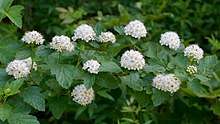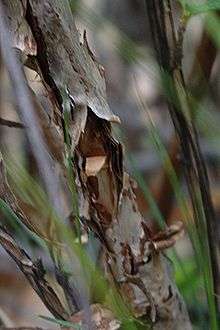Physocarpus
Physocarpus, commonly called ninebark, is a genus of flowering plants in the family Rosaceae, native to North America (most species) and northeastern Asia (one species).
| Physocarpus | |
|---|---|
 | |
| Physocarpus opulifolius | |
| Scientific classification | |
| Kingdom: | Plantae |
| Clade: | Tracheophytes |
| Clade: | Angiosperms |
| Clade: | Eudicots |
| Clade: | Rosids |
| Order: | Rosales |
| Family: | Rosaceae |
| Subfamily: | Amygdaloideae |
| Tribe: | Neillieae |
| Genus: | Physocarpus (Cambess.) Raf. 1836[1] |
| Species | |
|
6-20, see text | |
Description
Physocarpus are deciduous shrubs with alternately arranged leaves. The leaves are palmate with 3 to 7 lobes and often toothed edges. The inflorescence is a cluster of bell-shaped flowers with 5 rounded white or pink petals and many stamens. The fruit is a flat or inflated dehiscent follicle.[2][3] The genus name Physocarpus comes from the Greek for "bladder fruit", referring to the inflated fruits of some species.[4] The common name ninebark refers to the peeling bark of mature branches, which comes away in strips.[5]
Physocarpus opulifolius is cultivated as an ornamental plant. Several cultivars have been bred, particularly for foliage of varying colors, including 'Dart's Gold' and 'Luteus', which have yellowish leaves, and 'Monlo' and 'Seward', which have reddish purple foliage.[6]
Diversity
There are six[2][7][8] to 20[3] species in the genus.
Species include:

- Physocarpus alternans (M.E.Jones) J.T.Howell (1931) – dwarf ninebark (western North America)[9]
- Physocarpus amurensis (Maxim.) Maxim. (1879) – Asian ninebark (Asia)[10]
- Physocarpus australis (Rydb.) Rehder (1920)[11]
- Physocarpus bracteatus (Rydb.) Rehder (1916) – (Colorado)[12]
- Physocarpus capitatus (Pursh) Kuntze (1891) – Pacific ninebark (western North America)[13]
- Physocarpus glabratus (Rydb.) Rehder (1915) – (Colorado)[14]
- Physocarpus malvaceus (Greene) Kuntze (1891) – mallow ninebark (western North America)[15]
- Physocarpus monogynus (Torr.) J.M. Coult. (1891) – mountain ninebark (North America)[16]
- Physocarpus opulifolius (L.) Maxim. (1879) – common ninebark (eastern North America)[17]
- Physocarpus pauciflorus C.K.Schneid. (1906)[18]
- Physocarpus ribesifolia Kom. (1973)[19] – (Asia)
Synonyms
- Physocarpus hanceana Kuntze (1891) = Neillia hanceana (Kuntze) S.H.Oh (2006)[20]
- Physocarpus intermedius (Rydb.) C.K.Schneid. (1906) = Physocarpus opulifolius var intermedius (Rydb.) B.L.Rob. (1908)[21]
- Physocarpus torreyi (S. Watson) Maxim. (1879) = Physocarpus monogynus (Torr.) J.M.Coult. (1891)[22]
- Physocarpus stellatus (Rydb. ex Small) Rehder (1920) = Physocarpus opulifolius (L.) Maxim. (1879)[23]
Propagation
Propagation is by seeds sown as soon as ripe or they can be stored dry in airtight containers in a cool place for up to a year and then sown. Plants can be divided in the early spring, with a sharp spade or even an axe, chopping right through the middle. Softwood and hardwood cuttings are easy to root.
Problems
Garden writers describe few if any problems, but it is not unheard of armies of aphids attacking some varieties.
References
- Physocarpus Tropicos.org. Missouri Botanical Garden. 22 Jan 2012
- Physocarpus. The Jepson eFlora 2013.
- Physocarpus. Flora of China.
- Coombes, Allen J. (2012). The A to Z of Plant Names. USA: Timber Press.
- Physocarpus opulifolius 'Diabolo'. Missouri Botanical Garden.
- Common Ninebark, Physocarpus opulifolius'. University of Illinois Extension.
- Oh, S. H. and D. Potter. (2005). Molecular phylogenetic systematics and biogeography of tribe Neillieae (Rosaceae) using DNA sequences of cpDNA, rDNA, and LEAFY. American Journal of Botany 92(1), 179-92.
- Oh, S. H., et al. (2010). Phylogenetic relationship of Physocarpus insularis (Rosaceae) endemic on Ulleung Island: implications for conservation biology. Journal of Plant Biology 53(1), 94-105.
- "Physocarpus alternans". Natural Resources Conservation Service PLANTS Database. USDA. Retrieved 22 Jan 2012.
- P. amurensis Flora of China, www.eFloras.org 22 Jan 2012
- P. australis International Organization for Plant Information (IOPI) 22 Jan 2012
- "Physocarpus bracteatus". Germplasm Resources Information Network (GRIN). Agricultural Research Service (ARS), United States Department of Agriculture (USDA). Retrieved 4 January 2018.
- "Physocarpus capitatus". Natural Resources Conservation Service PLANTS Database. USDA. Retrieved 22 Jan 2012.
- P. glabratus Tropicos.org. Missouri Botanical Garden. 22 Jan 2012
- "Physocarpus malvaceus". Natural Resources Conservation Service PLANTS Database. USDA. Retrieved 22 Jan 2012.
- "Physocarpus monogynus". Natural Resources Conservation Service PLANTS Database. USDA. Retrieved 22 Jan 2012.
- "Physocarpus opulifolius". Natural Resources Conservation Service PLANTS Database. USDA. Retrieved 22 Jan 2012.
- P. pauciflorus International Organization for Plant Information (IOPI) 22 Jan 2012
- P. ribesifolia Tropicos.org. Missouri Botanical Garden. 22 Jan 2012
- "Physocarpus hanceana". Germplasm Resources Information Network (GRIN). Agricultural Research Service (ARS), United States Department of Agriculture (USDA). Retrieved 4 January 2018.
- P. intermedius Tropicos.org. Missouri Botanical Garden. 22 Jan 2012
- P. torreyi Integrated Taxonomic Information System (ITIS) 22 Jan 2012
- "Physocarpus stellatus". Germplasm Resources Information Network (GRIN). Agricultural Research Service (ARS), United States Department of Agriculture (USDA). Retrieved 4 January 2018.